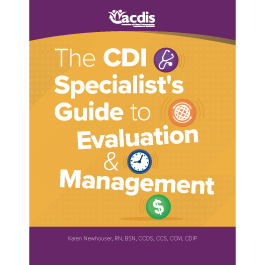Summer reading: Documentation guidelines for E/M

Evaluation and Management
By Karen Newhouser, RN, BSN, CCDS, CCS, CCM, CDIP
In addition to the Official Guidelines for Coding and Reporting applicable to the inpatient code assignment and the ICD-10-CM/PCS code set, two sets of guidelines exist solely for evaluation and management (E/M) coding—the 1995 and 1997 versions of the Documentation Guidelines for Evaluation and Management (DGs).
Before 1992, E/M codes were qualitative in nature, meaning that their use was based on provider interpretation of the level of care being provided to their patients. At that time, the E/M coding category comprised four pages in the current procedural terminology (CPT®) manual. Back then, the decision as to which code to use was fairly straightforward and proper code selection was based on the providers’ judgement.
In 1992, it all changed. The E/M section in the CPT® code manual went from four to 44 pages. The biggest change was a move from E/M codes being qualitative (in 1991) to becoming quantitative (in 1992). Later that year, the resource-based relative value scale (RBRVS) was born, with the purpose of allowing providers to assign a quantitative value of cost and/or resource consumption to every medical service and procedure that was directly initiated, supervised by, or participated in by a physician.
CMS developed the DGs in response to a lack of direction regarding E/M code use after their introduction in 1992. The first audit of those codes showed such a high error rate that CMS (then known as the Health Care Financing Administration) released the 1995 DGs to quantify the information needed for each key component.
While there are subtle differences in phraseology (with no difference in meaning) between the two DGs overall, the most substantial differences in the 1995 and 1997 versions occur in the examination section.
The 1997 version includes a general multi-system examination with various options available for single organ-system examinations. However, after the introduction of the 1997 DGs, there was much discussion regarding the examination section and a sole set of DGs couldn’t be agreed on, thus creating two sets of DGs.
CMS states in the Medicare Physician Fee Schedule, “Our prior attempts to revise the guidelines met with a lack of stakeholder consensus and support, which contributed to the current policy that allows practitioners to use either the 1995 guidelines or 1997 guidelines, resulting in further complexity in determining or selecting the applicable requirements.”
Some sources say physicians, via the AMA, provided some pushback after the 1995 DG publication causing the creation of the 1997 version. That latter version, however, occasioned even more pushback causing CMS to permit physicians to choose which DGs to follow per each patient encounter. However, the provider cannot use a combination of the DGs—he or she cannot pick a little from column A and a little from column B to suit their needs, so to speak—with one exception—effective September 10, 2013, the provider may use the 1997 DGs for an extended history of present illness along with other elements from the 1995 DGs to document an E/M service.
There is some common language in both the CPT® manual and the DGs; the reader is encouraged to refer to the CPT® manual for the complete descriptors for E/M services and instructions for selecting a level of service.
While ICD-10-CM/PCS code assignment follows a specific hierarchy of guidance, no similar instruction exists within the CPT® with the DGs serving as a type of adjunct guide to E/M code assignment.
The 1995 and subsequent 1997 DGs provide a great level of information and detail regarding the history and examination elements but leave medical decision-making relatively vague. This is felt to have led to the assignment of codes based on easily quantifiable components, giving less importance to the medical decision-making component, the section that speaks directly to medical necessity.
The DGs provide rules about what documentation is required to assign the different levels of E/M visits, which mainly involve counting elements of history, exam, and medical decision-making to determine each component level, and then comparing those levels to the different code requirements.
Editor’s note: This article is an excerpt from the CDI Specialist’s Guide to Evaluation and Management.
